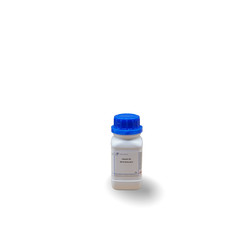You have no items in your shopping cart
Vitamin D3
Cholecalciferol (also abbreviated colecalciferol or calciol; vitamin D3 or incorrect vitamin D) is the useful physiological form of vitamin D in all non-vegetable eukaryotes and therefore also in humans. Cholecalciferol is a secosteroid and is also boosted in the body with the help of UVB radiation in the skin from 7-dehydrocholesterol.
In the diet it mainly occurs in oily fish or it is added to the feed as a dietary supplement. It has the function of a prohormone in the body and is represented through the intermediate calcidiol in its physiologically active form, the hormone calcitriol.
Cholecalciferol is a form of vitamin D that is naturally synthesized in the skin and functions as a prohormone and is displayed in calcitriol. This is important to maintain calcium levels and to modify bone health and development. As a medicine, cholecalciferol can be taken as a dietary supplement to prevent or treat vitamin D deficiency. One gram is 40,000,000 (40x106) IU, equivalent 1 IU is 0.025 µg. The dietary reference intakes for vitamin D (cholecalciferol and / or ergocalciferol) have been established and the recommendations depending on the country:
Low vitamin D levels are more commonly found in individuals living in the original race degrees, or for other reasons for minor to rapid exposure, such as being housebound, frail, elderly, obese, dark-skinned, or clothing which bears most of the skin covered. Supplements are recommended for these groups of people.
The Institute of Medicine recommended a maximum intake of vitamin D of 4,000 IU / day in 2010, finding that the dose for the lowest minimum adverse event level was 40,000 IU per day for at least 12 weeks, and there was a single case of toxicity above 10,000 IU after more than 7 years of daily intake; this case of toxicity occurred in circumstances that have placed other children in dispute as a plausible case to consider when making recommendations for vitamin D intake. Patients with severe vitamin D deficiency are on treatment with a loading dose required; its size can be calculated based on the actual serum 25-hydroxy vitamin D content and body weight.
There are conflicting reports on the effectiveness of cholecalciferol (D3) versus ergocalciferol (D2), with some studies suggesting one between efficacy of D2 and others showing no difference. There are differences in absorption, binding and inactivation of the two forms, with evidence that cholecalciferol is usually beneficial for increasing blood levels, although more research is needed.
A much less common application of cholecalciferol therapy in rickets uses a single large dose and is called stoss therapy. Treatment is given orally or by intramuscular injection from 300,000 IU (7,500 µg) to 500,000 IU (12,500 µg = 12.5 mg), in a single dose, or sometimes in two to four divided doses. There are concerns about the safety of such high doses.

